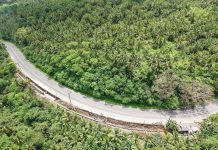TACLOBAN CITY – The regional office of the Bureau of Fisheries and Aquatic Resources (BFAR) has issued stern warning against consumption of shellfish following recent spate of widespread red tide bloom in Eastern Visayas that has already killed two children. The BFAR-8 said that red tide toxins found on May 27 in Irong-Irong Bay in Tarangnan, Samar and Cambatutay Bay in Catbalogan City have extended to nearby Maqueda Bay, Villareal Bay and Carigara Bay. Maqueda Bay which encompasses the town of Jiabong, Catbalogan City, Motiong, Paranas, Pinabacdao, Hinabangan, San Sebastian, and Calbiga, all in Samar, is a major source of mussel in the region.
The area has been shipping shellfish to Manila for export. BFAR Regional Director Juan Albaladejo said that a family of seven from Barangay Cagutsan, Sierra Island in Catbalogan City was brought to the Samar Provincial Hospital (SPH) and later to the Eastern Visayas Regional Medical Center (EVRMC) after consuming pen shell locally known as “sarad.” An 11-year-old girl from the family died due to paralytic shellfish poisoning on July 17. On July 20, another family from Brgy. San Andres, also in Catbalogan, consumed mussels for dinner bought from a village market. Two of their children were hospitalized after suffering severe stomach pain. The five-year-old boy succumbed at the SPH the same day due to dehydration. As of this week, seven patients are still confined in hospital after eating red tide-infected shellfish. The fisheries bureau asked local government units to assist in the information drive and enforcement of shellfish ban, which strictly prohibits consumption, trading, and transport of shellfish gathered from infested bays.
“It’s unfortunate that these incidents happen despite (our) effort to warn the public starting from the onset of red tide recurrence,” Albaladejo said. “We reiterate our public advisory to refrain from eating, harvesting, marketing, and buying shellfishes from affected bays until such time that the shellfish toxicity level has gone down below the regulatory level,” he added. Fish, squid, shrimp and crab are safe to eat “provided that they are fresh and washed thoroughly and internal organs such as gills and intestines are removed before cooking,” according to BFAR.
In Eastern Samar, BFAR also raised red tide alert over Matarinao Bay after they found toxins from shellfish meat samples gathered from the bay. In its advisory issued late afternoon on July 22, the fisheries bureau disclosed that there are 65 saxitoxins per 100 grams of meat from shellfish gathered in Matarinao Bay. “This is above the regulatory limit because the normal should be below 49 saxitoxins per 100 grams of shellfish meat,” Albaladejo said. Saxitoxin is a principal toxin responsible for a human illness known as paralytic shellfish poisoning. Some shellfish can store this toxin for several weeks and very harmful if consumed by humans. Fish from affected bay are safe for human consumption so long as they are cleaned and washed thoroughly and internal organs are removed before cooking. Matarinao Bay covers the coastal waters of Salcedo, Quinapondan, Hernani, and Gen. MacArthur in Eastern Samar. The bay has been subject to regular monitoring after recurrence of red tide bloom. The last one was in 2013, which lasted for almost a year. In the last quarter of 2015, the region was hit by what the BFAR described as the biggest red tide bloom that has not been seen in more than three decades. (SARWELL Q. MENIANO/JAZMIN BONIFACIO)



